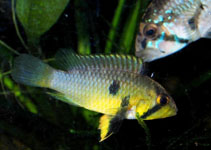| Family: |
Cichlidae (Cichlids), subfamily: Geophaginae |
| Max. size: |
6.37 cm SL (male/unsexed) |
| Environment: |
benthopelagic; freshwater; pH range: 4.8 |
| Distribution: |
South America: known only from around the Tierra típica northwest of Pebas, Peru. |
| Diagnosis: |
Dorsal spines (total): 14-16; Dorsal soft rays (total): 6-8; Anal spines: 3-4; Anal soft rays: 5-8. Distinguished from all congeners by the combination of the following characters: over-proportionally large head and mouth with massive jaws and hypertrophic lips in adult males, 3 infraorbital pores; a lyrate caudal fin in adult males with immaculate lemon-yellow lower lobe and vertical rows of spots in its upper bluish hyaline lobe, truncate and immaculate in females; extended first membranes of the dorsal fin, a distinct breast band in basal part of vertical bar 2 and posterior lateral spot in female; and absence of caudal peduncle spot (Ref. 75695). |
| Biology: |
Appears to be restricted to forest streams, with a preference for fast-flowing, cooler, and crystal-clear, acid to neutral water (Ref. 75695). A reddish morph of this species was collected in a small clearwater igarapé, about 1 meter wide and approximately 30 cm deep, with fine white sandy bottom, no submerged vegetation, rocks or pebbles, a pH of 4.8 at a temperature close to 29°C (Ref. 75695). |
| IUCN Red List Status: |
Least Concern (LC); Date assessed: 24 April 2014 Ref. (130435)
|
| Threat to humans: |
harmless |
Source and more info: www.fishbase.org. For personal, classroom, and other internal use only. Not for publication.

